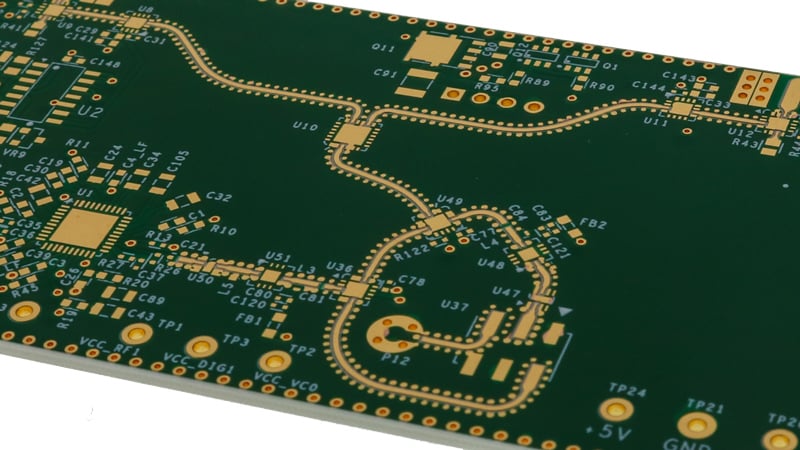Printed circuit board (PCB) laminates play a crucial role in the performance and reliability of electronic devices. Among the popular choices in the industry are Rogers and Taconic laminates.
In this blog post, we will compare these two types of laminates, highlighting their similarities and differences as well as their respective advantages and disadvantages.
Similarities
Rogers and Taconic laminates, widely recognized in the electronics industry, exhibit several key similarities that render them particularly advantageous for diverse applications. Both materials boast exceptional electrical insulation properties, ensuring minimal electrical interference and high performance in sensitive circuits. Their high thermal conductivity is pivotal for efficient heat dissipation, a critical factor in maintaining the longevity and reliability of electronic components, especially in high-power and high-speed environments.

Printed circuit board manufactured with Rogers laminate material.
Furthermore, the good dimensional stability of these laminates means they retain their shape and size under varying environmental conditions, which is crucial for maintaining the integrity of precision electronic assemblies.
Signal Integrity
In terms of signal integrity, Rogers and Taconic laminates are particularly adept at handling high-frequency signals. Their composition minimizes signal loss, a vital attribute for applications in high-speed digital and RF domains, where maintaining signal clarity is paramount. This makes them ideal for use in advanced communication systems, aerospace electronics, and other high-performance applications.
Manufacturing Process
The manufacturing process of both Rogers and Taconic laminates involves a meticulous layering of copper and dielectric materials. This process not only ensures the homogeneity and consistency of the final product but also contributes to its ease of fabrication. Such a manufacturing approach allows for precise control over the laminate's properties, enabling customization to meet specific application requirements. This similarity in manufacturing techniques underscores the laminates' adaptability and reliability, making them a preferred choice for a wide array of electronic applications, from consumer electronics to specialized industrial equipment.
Differences
While Rogers and Taconic laminates have similarities, there are distinct differences between them that set them apart. One key difference lies in their composition. Rogers laminates are made of a ceramic-filled PTFE (Polytetrafluoroethylene) material, which provides excellent electrical performance and thermal stability. On the other hand, Taconic laminates typically utilize woven fiberglass cloth impregnated with a polymer resin, such as epoxy, offering a balance between cost-effectiveness and performance. This variation in composition affects their electrical properties, thermal conductivity, and cost factors.
Advantages of Rogers Laminates
Rogers laminates offer several advantages that make them a preferred choice for specific applications. Firstly, their high dielectric constant (εr) and low dissipation factor (Df) make them ideal for RF and microwave applications where signal integrity is critical. They provide superior electrical performance with minimal signal loss, enabling precise transmission of high-frequency signals. Rogers laminates also exhibit excellent thermal conductivity, allowing effective dissipation of heat in high-power applications, thereby enhancing overall reliability.
Furthermore, Rogers laminates offer dimensional stability and low moisture absorption, ensuring consistent performance over a wide range of environmental conditions. However, it's important to note that Rogers laminates tend to be higher in cost compared to traditional FR-4 materials, which can impact project budgets.
Advantages of Taconic Laminates
Taconic laminates bring their own set of advantages to the table, making them a popular choice in various applications. One notable advantage is that Taconic laminates exhibit good mechanical strength and flexibility, making them suitable for applications that involve bending or shaping the PCB. They also provide good chemical resistance, enhancing their durability in challenging environments.
Taconic PTFE-based laminates provide exceptional electrical performance, low loss, and wide operating temperature ranges, making them ideal for RF and microwave applications, including radar systems, satellite communications, and wireless infrastructure.
Disadvantages
Despite their advantages, both Rogers and Taconic laminates have certain drawbacks to consider. Rogers laminates, as mentioned earlier, can be costlier than other options, which may be a limiting factor for projects with tight budgets. On the other hand, Taconic laminates may have slightly lower electrical performance compared to Rogers laminates, making them less suitable for extremely high-frequency or high-power applications. Taconic laminates may have limitations in terms of their thermal conductivity, which can affect their ability to dissipate heat in demanding thermal environments.
Along with that, Taconic's PTFE-based laminates can have higher fabrication costs due to their specialized manufacturing process and may require careful attention to ensure compatibility with standard PCB fabrication techniques.
Isola Advanced Laminates
It is also important to note that Isola also offers a range of advanced laminates specifically designed for high-speed digital applications. These laminates are engineered to provide excellent electrical properties, low dielectric loss, and tight control of electrical parameters necessary for high-frequency signal transmission.
Isola's high-frequency laminates, such as the IS400, I-Speed®, and Astra® series, are designed to meet the demanding requirements of modern communication systems, computing, networking, and other high-speed digital applications. These laminates enable the design of high-performance PCBs with enhanced signal integrity and reliability. And while their product offering is not as broad as the others, the material is much more cost effective to purchase and process.
Summary
Rogers and Taconic laminates are two prominent options in the PCB industry, each with its own strengths and weaknesses. Understanding their similarities, differences, advantages, and disadvantages is crucial in making an informed decision when selecting the right laminate for specific electronic applications. Assessing the project requirements, performance needs, and budget considerations will help in determining the most suitable laminate for your PCB design.
Key Takeaways
- Shared strengths: Both Rogers and Taconic laminates provide excellent electrical insulation, dimensional stability, and high thermal conductivity, making them reliable in high-frequency and high-power PCB applications.
- Signal performance: Both materials minimize signal loss, which is critical for RF, microwave, and high-speed digital circuits, enabling their use in aerospace, telecom, and advanced communication systems.
- Material composition differences: Rogers uses ceramic-filled PTFE for superior electrical and thermal properties, while Taconic typically relies on woven fiberglass with polymer resins, offering a balance of performance and cost.
- Application advantages: Rogers laminates excel in RF/microwave performance, thermal conductivity, and moisture resistance, though they come at a higher cost. Taconic laminates provide good mechanical strength, flexibility, and chemical resistance, with PTFE-based options also supporting RF applications.
- Cost and trade-offs: Rogers laminates tend to be more expensive but offers best-in-class electrical performance. Taconic is more budget-friendly but may fall short in extremely high-frequency or high-power designs. Isola laminates also provide a cost-effective option for high-speed digital applications.
















